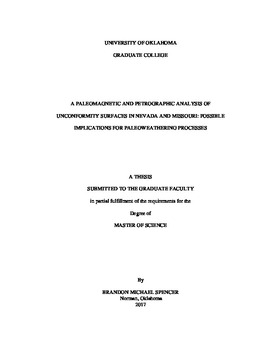| dc.description.abstract | Paleomagnetic dating has proven to be a valuable tool in dating geologically significant events such as timing of deposition, deformation, or diagenesis. When combined with petrographic methods and field relationships, we can often accurately constrain the timing of these events and elucidate a more complete picture of the geologic history of a formation or region. This study combines paleomagnetic, petrographic, and rock magnetic study of crystalline basement rocks, their upper bounding unconformity, and overlying sedimentary cover in two locations in Nevada and Missouri. First, the unconformity between the Proterozoic Vishnu Group granites and schists and overlying Cambrian Tapeats Sandstone in southern Nevada represent almost one billion years of missing rock record. Prior to deposition of the Tapeats, it is likely that the Vishnu underwent subaerial exposure for an extended period of time and may have recorded surficial processes caused by the penetration of supergene fluids enriched in weathered material. Paleomagnetic and rock magnetic analysis of Vishnu and Tapeats specimens revealed stable ancient magnetizations in both lithologies. A characteristic remanent magnetization held primarily in magnetite in rocks from four Vishnu sites exhibits north to northeasterly declinations and moderately steep up inclinations and yields a paleopole at 16.3°S latitude and 129.9°W longitude, which falls near the Mesoproterozoic portion of the apparent polar wander path for North America. This magnetization was likely acquired during the end stages of metamorphism in the Mesoproterozoic and is interpreted as a thermoremanent magnetization acquired during cooling following metamorphism. Petrographic analysis of Vishnu specimens reveals the presence of titanomagnetite as an igneous accessory mineral in the rocks. Magnetizations in the Tapeats Sandstone, although stable, contain scattered directions and are interpreted as the product of time-progressive acquisition of magnetizations in hematite grains acquired over a long period of time. Unfavorable local climatic conditions or subsequently eroded sedimentary units may have prevented the basement from acquiring or preserving a magnetization in hematite during exposure in the late Proterozoic. The second part of this work evaluates the Proterozoic Butler Hill Granite and Grassy Mountain Ignimbrite and overlying Cambrian Lamotte Sandstone of the St. Francois Mountains in southeastern Missouri. Like the unconformity surface in Nevada, the contact between basement and sedimentary cover in Missouri represents nearly one billion years of time and is known to contain variable topographic relief on the surface of the Proterozoic basement. Paleomagnetic directions in the igneous rocks are westerly and moderately steep down, corresponding to a paleopole of 3.4°S latitude and 145.1°W longitude, agreeing with a previously published primary Mesoproterozoic (1.476 ± 16 Ma) magnetization. This is interpreted as a primary magnetization held predominantly in magnetite acquired during emplacement and eruption of the rocks. Petrographic and rock magnetic analysis confirms magnetite as the magnetic carrier. The Lamotte Sandstone contains a stable ancient magnetization with southeasterly declinations and moderate down inclinations, corresponding to a paleopole of 14.7°N latitude and 126°W longitude, on the Silurian portion of the apparent polar wander path for North America, with an error ellipse that overlaps the Mississippian. This is interpreted as a chemical remanent magnetization held in magnetite acquired during the late Devonian to early Mississippian from subsurface fluid flow in the St. Francois aquifer during movement of Fe-rich ore-forming hydrothermal fluids. The silica-rich, impermeable Grassy Mountain Ignimbrite likely served as a protective seal for the crystalline basement and prevented penetration of supergene or orogenic fluids into the upper basement rocks, preserving the primary magnetization held in the ignimbrite and the Butler Hill Granite. | en_US |
